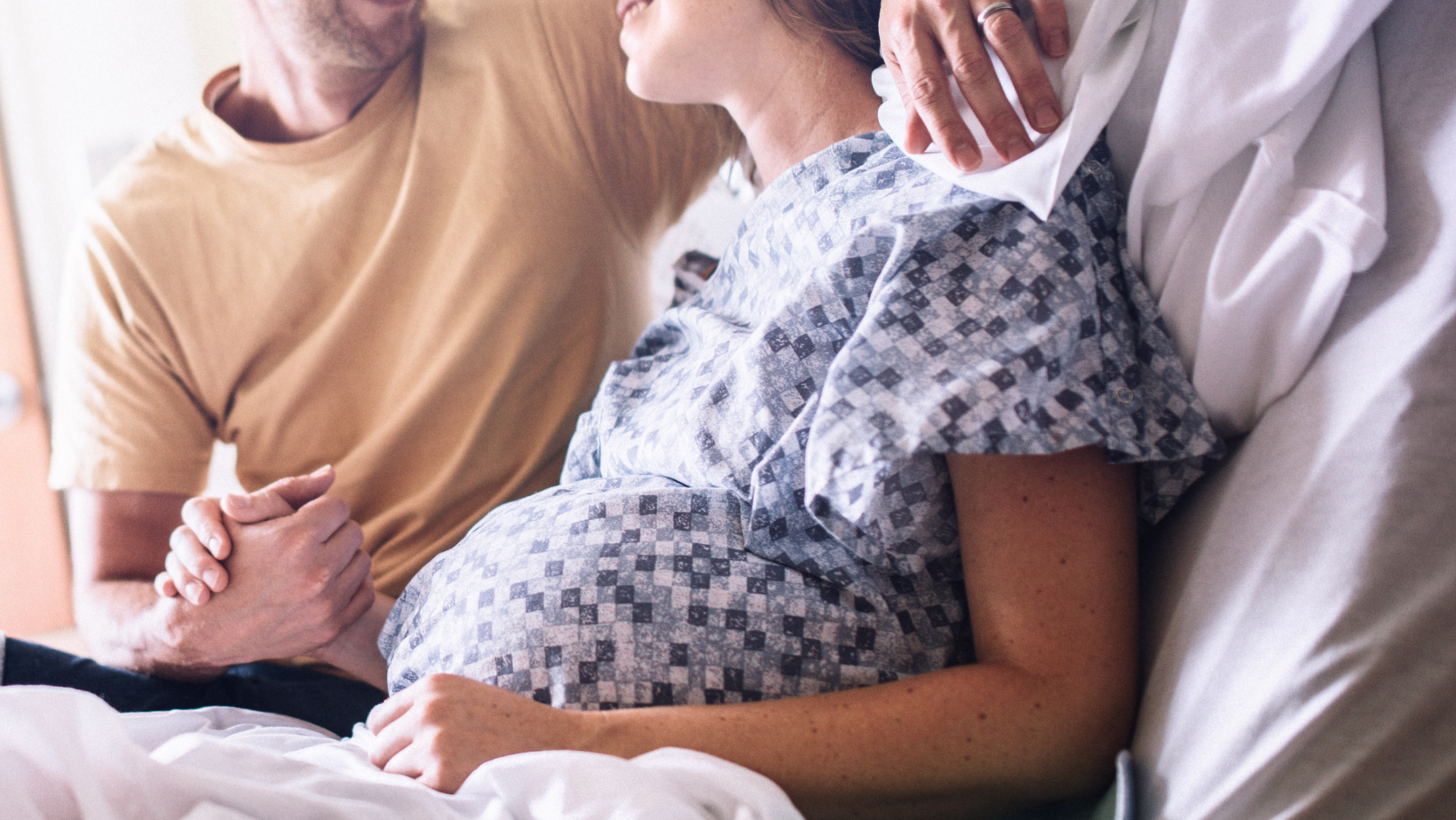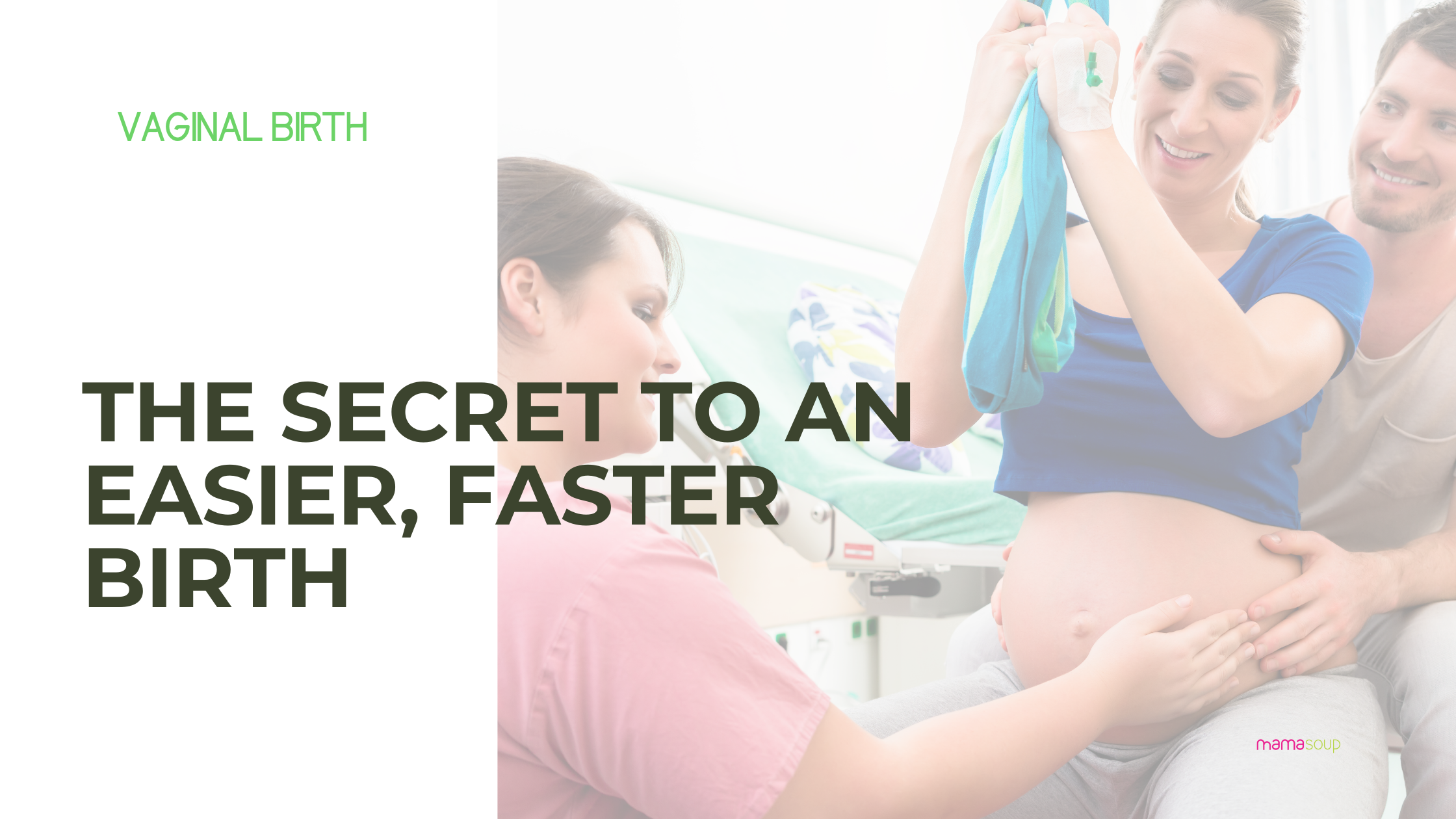What Every Pregnant Person Needs to Know About Caesarean Section
When you're expecting a baby, a lot of things run through your mind and the way you'll end up giving birth is probably at the top of your list! Whether you're planning to have a vaginal birth or a caesarean section (C-section), you've got lots of questions.
One thing I realized when I worked with new moms in the hospital was that many had no idea that a vaginal birth is the safest way to give birth, for mom and baby.
Wanna Have a Stress-Free C-Section, Mama?
Grab access to our FREE online program that takes you from scared to prepared!
GET INSTANT ACCESS $0 >>
There's a lot more to a caesarean than a scar. If you've been wondering what the real difference is, read on!
What's the difference between a vaginal birth and a caesarean section?
A vaginal birth is the most common type of delivery and it occurs when the baby moves down the birth canal during the stages of labour and is born through the vagina.
A caesarean section is when the doctor has to perform surgery on your tummy to cut through the layers and deliver your baby through the incision. It's considered major abdominal surgery.
No matter how you're planning to have your baby, it's important to talk to your doctor or midwife about the risks and benefits of both so you can be certain you're making the right birth decision for you and your baby.
The history of caesarean section
The story is that the Roman dictator, Julius Caesar, was the first baby ever born by caesarean section because his mother died during childbirth, but there's actually wide spread speculation that she was alive when he led the invasion of Britain.
The truth is that babies have been born by c-section since the ancient times. Apparently Caesar had the procedure named after himself because he declared that all women who were dead or dying during childbirth would have their babies surgically removed in an attempt to increase the population. Back then, caesarean sections were a last resort to save an infant but today things are much, much different!
How many people have a caesarean section each year?
In 1995, the Canadian rate for Cesareans was about 17%. In 2018, it was 28%. In the United States in 2018, the average rate for Cesareans was almost 33%.
Experts agree that the current rate of caesarean section is too high.
The worst part about these stats is that the World Health Organization (WHO) recognizes that only 10-15% of all caesareans are really necessary
Four reasons the C-section rate has climbed
Although the climbing rate of caesarean section is complex, there are some obvious reasons for more people to give birth this way.
Those include:
-
Women are having babies later in life which does put them in a bit of a higher risk category.
-
With the surge of fertility options available now, many women are experiencing high-risk pregnancies with more than one baby.
-
Human error: misreading a fetal heart monitor. (it happens: even doctors are only human!)
-
Unfortunately, inductions and epidurals are partly to blame. Women need mobility during childbirth to change the position of their pelvis (squatting can increase your pelvic size 30 percent!!) to give the baby room to turn and to use gravity to help the baby down the birth canal. When a women says yes to the drugs, she is committing herself to immobility. This increases her chances of experiencing interventions (forceps, anyone?) which makes her more likely to have a caesarean.
Sadly, another reality for the increase in caesarean section is all on doctors: c-sections are easier to schedule and they're worth more money to the person performing them. It's not a secret that obstetricians make more money when they deliver a baby surgically. It’s just the facts.
The benefits of having a C-section
The benefits of having a caesarean section depend on what's happening during your pregnancy and birth! During pregnancy your doctor may discover conditions that would make vaginal birth too risky for you or your baby.
These include:
- Issues with the placenta (example: placenta previa)
- Certain birth defects that could make passing through the birth canal stressful or life-threatening for a mom or baby.
- Health conditions that may affect the mom’s ability to have a vaginal birth: things like really high blood pressure or active genital herpes.
During labour, you may need to have a C-section if the baby's heart rate drops because it may be a sign they aren't getting enough oxygen. Or maybe your baby turned to a footling breech (when the feet are coming down the birth canal first, instead of the head).
The benefits of having a vaginal birth
Vaginal birth is generally easier on your body than having a caesarean even though they take longer and require a lot of hard work. It's usually much shorter to recover from a vaginal birth and less painful. In fact, a vaginal birth usually means you can spend more time bonding with your baby.
Research shows us that vaginal birth is good for your baby, too. The hormones that cause your body to go into labour actually trigger your baby to get ready to be born and help them breathe easier. Having a baby born vaginally also means they have a lowered risk of serious childhood diseases like asthma, diabetes, obesity and allergies.
Why? Researchers think it's because babies born by vaginal birth are exposed to healthy bacteria during vaginal birth.
The risks of having a caesarean section
No matter how you look at it, C-sections are major surgery. Surgery of any kind comes with risks like:
- Infection
- Serious bleeding
- Injury to other organs (like your bladder or bowel)
- Injury to blood vessels
- Pelvic floor issues in the future
The risks to the baby are significant, too. Babies born after a caesarean are more likely to have breathing issues that need treatment in the newborn intensive care unit. They are also at risk for injury from the instruments used during the surgery.
The risks of having a vaginal birth
Even though the skin around the opening to the vagina can stretch a lot so a baby can be born, many people end up with tears that require a few stitches. Other risks of vaginal birth are:
- More serious vaginal tears that take longer to heal
- Weakened muscles that can lead to leaking urine or feces
Babies may develop nerve or bone injuries during the birthing process if they become stuck in the vaginal canal.
Will this birth affect my next birth?
The way you give birth will definitely have an effect on your next birth in two ways: it will have an effect on your choices and your safety.
How will having a caesarean section change my choices for my next birth?
Research shows us that most people can have a C-section and then safely have a vaginal birth for the next baby. The problem is that many hospitals and healthcare providers don't strongly support or offer a vaginal birth after caesarean (also called a VBAC). Because of that, it will make you more likely to have a C-section the next time. Even if you do plan to have a VBAC the next time, you will probably have fewer choices about where you can give birth or which procedures you'll have.
For instance, you may have a hard time finding a doctor who will let you birth without a lot of monitoring or an intravenous in your arm which can hinder your movement in labour.
How will having a caesarean section affect my safety?
No matter how you give birth the next time, your pregnancy will be considered higher-risk. What you don't see after you have a C-section is the scar on the inside of your body along your uterus. That scar can come apart as your pregnancy grows or it can cause problems for the placenta to properly attach.
Unfortunately, you chance of having a stillbirth is more common after a caesarean and so is the risk of serious bleeding that would require more surgery to manage. It can even mean that you'll lose your uterus and not be able to have any more babies.
The more C-sections you've had, the greater the risks are. Even if you don't plan to have any more babies, it's good to know about these risks because there's always a chance of an unplanned pregnancy.
Ten ways to safely prevent a caesarean section
Let's just be very clear: not all C-sections are preventable but many are. It's important to stay informed about the decisions you're making about your birth so you don't end up having a caesarean that you don't want or really need. Just by reading this, you're already informing yourself!
There's a lot of research about lowering your risk of a C-section safely, and that includes:
1) Finding a doctor with a low caesarean rate.
Obviously the rate of C-sections vary by country, province or state and even city due to birth trends. This is usually because doctors have been trained to practice a certain way, rather than meeting the needs of birthing people.
When I teach my prenatal caesarean class to new parents, we talk about how to interview your doctor to ask about these issues. It can be hard to imagine that you could interview your doctor, but it's a great idea to make sure you're compatible!
2) Stay active during pregnancy to prepare your body for the challenges of labour.
It takes a lot of strength for your body to manage the stages of labour to give birth to a baby, so getting lots of regular exercise while you're pregnant can get you into shape for the biggest workout of your life!
3) Hire a doula.
I've said it before and I'll say it a million zillion times- doulas are an invaluable resource for your birth! Research shows that hiring a doula can reduce your chance of having a caesarean section by 30 percent!
4) Get lots of extra rest and sleep during the last stages of pregnancy to prepare for the challenges of having a baby.
Rest, sleep and relaxation are such an important part of maintaining a healthy pregnancy that I always include it in my online prenatal courses.
5) Don't agree to an induction unless there's a medical reason.
Sometimes when you get the the end of your pregnancy, you'll agree to an induction because you just want it to be over. But that isn't always the safest decision for you or your baby, so ask for a medical reason if your doctor suggests inducing labour.
6) Labour at home as long as possible.
A normal labour can take anywhere from twelve to twenty-four (or more!) hours. Spending time at home eating, drinking, resting and moving around freely in early labour is most likely the best place for you to be. Try to stay away from the hospital until you're in active labour.
7) During labour, stay upright and move around.
Change positions and try to manage your pain without any drugs. Ask to have your baby's heart rate monitored by a handheld device, rather than being strapped in a bed to a machine.
8) If you've had a caesarean section: choose a doctor or midwife who is supportive of a VBAC.
Make sure they understand how much you'd prefer to have a vaginal birth this time around and make sure they're comfortable and supportive of your wishes.
9) If your baby is breech (bum or feet-first) near the end of your pregnancy, ask for suggestions to turning the baby so they're head-first.
There are ways proven by studies to turn a breech baby. Don't accept a caesarean until you've exhausted all of your options.
10) Choose a location for your birth with a low rate of C-section.
One of the best ways to lower your risk of an unnecessary caesarean section is to choose a setting with a low C-section rate. Hospitals may vary greatly as far as their rate of caesarean, even if they're located within the same city. In general, you're less likely to have a C-section in a birth centre than you are in a hospital.
How do I know if my caesarean section is medically necessary?
It's really difficult to know if your C-section could be avoided because you want to trust that your doctor has your best interests at heart.
Sometimes, you may be offered a caesarean when research shows us that a vaginal birth would probably be safer. These include:
A healthy pregnant person with a suspected "big baby"
It's very difficult to guess a baby's size in the womb, even with an ultrasound: the estimations can be off by two pounds either way! Also, lots of people can vaginally birth a 12-pound baby naturally because your vagina is made to stretch.
A slow labour, but everyone is doing well
A normal labour can last days and be perfectly healthy. If everyone is tolerating labour well, there's probably no reason to need a C-section.
When labour has stalled, but changing positions and moving around helps get things going again.
Another great reason to hire a doula is that they remind you to change positions and move
The takeaway
Caesarean section is a major abdominal surgery that comes with risks for you and your baby. Even though a C-section is needed is some births, they're occurring far too often and it puts people's health at risk.
If you do need to have a caesarean birth, check out my best tips for your recovery.
Post Gallery
Hey there, I’m Joanne.
I’ve spent about 20 years serving women as a nurse, doula and Lamaze educator. I have 4 kids and I know firsthand how lonely and isolating motherhood can be, so I created MamaSoup. I'm mostly known for my love of red wine, spontaneously singing and my confidence in being my true self on social media. When I’m not busy building women up, you can catch me taking Instagram stories of my bulldog Ruby, watching The Handmaid’s Tale, playing MUber (Mom Uber) to my kids or vacationing in my favourite town: Cabo San Lucas, Mexico.
I love serving the world by providing a space for moms to connect and support each other. In my opinion, moms are the backbone of communities because they are (literally) raising the future!
As the founder and CEO of MamaSoup, I’ve been featured on CHEX TV Morning Show, KawarthaNOW, Economic Development- The City of Kawartha Lakes and MyKawartha.
Still with me? Join me over at MamaSoup to keep the conversation going!
Read More










